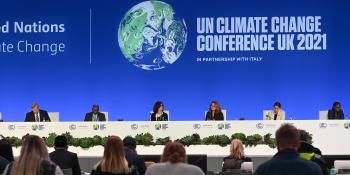Analysis of Paris Agreement pledges informs UNFCC negotiations

Summary
To show the presence of agriculture in the Intended Nationally Determined Contributions (INDCs) ahead of the Conference of the Parties (COP) in Paris in December 2015, CGIAR Research Program on Climate Change, Agriculture and Food Security (CCAFS) and several partners systematically reviewed the 160 submitted INDCs of the parties to the United Nations Framework Convention on Climate Change (UNFCCC). The analysis demonstrated a country-driven demand for mitigation of agricultural emissions for non-annex 1 countries. UNFCCC country negotiators, donors, and climate finance investors used this and subsequent analyses to advocate that agriculture is a critical sector to address in climate policy and should be prioritized in climate finance.
Background
All 197 parties to the UNFCCC had committed to submit their INDCs ahead of the COP in Paris in December 2015. In their INDCs, the parties outlined their climate change mitigation and adaptation plans, informing the COP on the need for action. By November 2015, 160 parties had submitted their INDCs, but the prominence of agriculture in these was only evidenced when CCAFS published its first analysis on them.
To inform researchers and negotiators on the importance of agriculture for climate change mitigation and adaptation, CCAFS and several partners reviewed the INDCs systematically: What countries included agriculture in their mitigation and adaptation plans? What practices did they prioritize? How much financial support was necessary for their implementation?
The analysis showed that agriculture and land use were key strategies for climate change mitigation and adaptation in a majority of countries. Agriculture was particularly important in the contributions of non‑Annex 1 countries, which count on international assistance to meet their mitigation targets. CCAFS concluded that climate finance should include agriculture as a key sector and these countries should be supported with the measurement, reporting and verification of greenhouse gas emissions. CCAFS disseminated this analysis, its underlying data and subsequent updates successfully through various channels. A press report released during the COP in Paris was picked up by international media. The results were presented to researchers and negotiators in Bonn and Marrakech in preparation for the COP in 2016, and in two workshops to staff of USAID. In addition, the World Bank requested CCAFS to carry out additional analyses and contribute to a discussion paper. Moreover, impact investor Root Capital incorporated the analysis into their strategies for low-emissions development assistance.
Key facts
- Access to weather and climate information services are a key component of increasing climate resilience.
- The analysis demonstrated that climate finance should include agriculture as a key sector to assist non-annex 1 countries in meeting their mitigation targets.
- The analysis shaped planning among development organizations by demonstrating a country‑driven demand for mitigation of agricultural emissions.
Lessons: Key elements of success
- CCAFS’ analysis of the INDCs enabled organizations, negotiators and media to stress the importance of agriculture for climate change mitigation.
- CCAFS capitalized on the interest in climate change during the COP in Paris to disseminate the importance of climate-smart agriculture.
- The dissemination of the analysis’ results through different channels increased their impact.
Further reading
- World Bank report: Making climate finance work in agriculture
- Report: The Economic Advantage: Assessing the value of climate-change actions in agriculture
- Press release: Report: Majority of national climate plans address agriculture, but most lack funds for footing annual USD 5 billion bill
- 2016 Annual Report story: Countries and partners use CCAFS science and analysis to put the Paris Agreement into action
Related research outputs
- Info Note: How countries plan to address agricultural adaptation and mitigation
- Dataset: How countries plan to address agricultural adaptation and mitigation: An analysis of Intended Nationally Determined Contributions
- Info Note: Agriculture's prominence in the INDCs
- Info Note: Agriculture's contribution to national emissions


